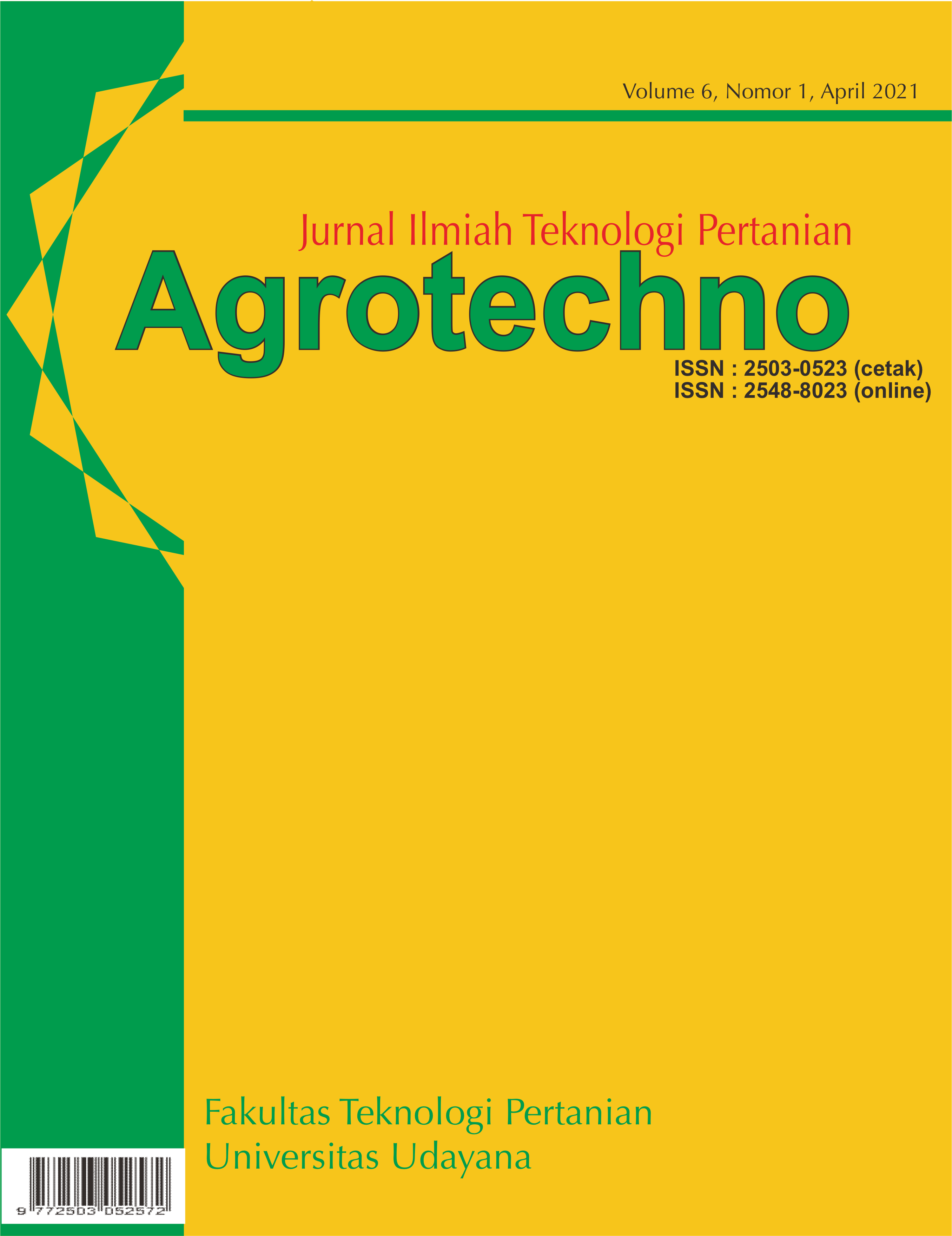Uji Aktivitas Antoksidan dan Senyawa Fitokimia pada Tanaman Terung Pokak (Solanum torvum)
Abstract
Pokak eggplant fruit in Indonesia was quite abundant as a wild plant. The research aimed to test antioxidant activity and phytochemical compounds of Pokak eggplant plant. The research method used quantitative analysis: DPPH and phytochemical moisture content. The results are fresh fruit research results: water content 82.2%, ash content 1.64%, protein 9.77%, fat 4.63%, carbohydrates 4.54%, Vitamin C 3.78%, phenol 33.95 mg/g, Tannins 0.94 mg/g, Flavonoids 1,38 mg/g, DPPH 85.58%. Seeds: water content 39.90%, ash 1.16%, protein 6.22%, fat 0.48%, carbohydrates 52.97%, Vitamin C 2.46%, phenol 21.84 mg/g, Tannins 0.52 mg/g, Flavonoids 2.32 mg/g, DPPH 86.88%. Dry stem: water content 6.88%, ash content 7.92%, protein 14.28%, fat 6.90%, carbohydrate 64.02%, Vitamin C 0.13%, phenol 92.14 mg/g, Tannin 1.61 mg/g, Flavonoids 8.04 mg/g, DPPH 78.47%. Fruit skin: water content 58.16%, ash content 0.26%, protein 5.74%, fat 0.32%, carbohydrates 35.29%, Vitamin C 1.34%, phenol 25.53 mg/g, Tannins 0.53 mg/g, Flavonoids 2.76 mg, DPPH 85.49%. Fresh Leaves: water content 58.16%, ash content 0.26%, protein 5.74%, fat 0.32%, carbohydrates 35.29%, Vitamin C 1.34%, phenol 25.53 mg/g, Tannins 0.53 mg/g, Flavonoids 2.76 mg/g, DPPH 85.49%. Dried Leaves: water content 7.52%, ash content 7.52%, protein 25.84%, fat 3.67%, carbohydrates 50.52%, Vitamin C 1.31%, phenol 12.87 mg/g, Tannins 0.20 mg/g, Flavonoids 1.76 mg/g, DPPH 64.50%.
Downloads
References
Arthan D, Prsatkittakoop, Esen A, and S. J. (2006). Rostano Ful Glycoside 26-O-Beta Glucosidase From The Leaves of Solanum toorvum. Jurnal Phytochemistry, 67(1), 22–33.
Bourne, MC. (2002). Food Teture and Viscosity: concept and measurement.
Gandhi, G. R., Ignacimuthu, S., Paulraj, M. G., & Sasikumar, P. (2011). Antihyperglycemic activity and antidiabetic effect of methyl caffeate isolated from Solanum torvum Swartz. fruit in streptozotocin induced diabetic rats. European Journal of Pharmacology, 670(2–3), 623–631. https://doi.org/10.1016/j.ejphar.2011.09.159
Inggrid, M., & Santoso, H. (2014). Ekstraksi Antioksidan Dan Senyawa Aktif Dari Buah Kiwi ( Actinidia deliciosa ). Lembaga Penelitian Dan Pengabdian Kepada Masyarakat, III(3), 43.
Jackson LP, Castilo AA, Lores OF, Hernandez JB, Salas HJ, Zapata EP, Diaz NW, and T. Y. (2010). Toxicity By Repeated Does Of Solanum torvum SW Decoction (prendejera) In Rats. Revistas. http://www.bsv.sid.cu/revistas/pla/vol-15-2-10/plao6210.htm
Jaiswal, B. S. (2012). Solanum torvum: A review of its traditional uses, phytochemistry and pharmacology. International Journal of Pharma and Bio Sciences, 3(4), 104–111.
Laili D.H.N., Nofianti, dan T. (2014). Penulusuran Potensi Antifertilitas Buah Takokak [Solanum Torvum S] Melalui Skrining Fitokimia Dan Pengaruhnya Terhadap Siklus Estrus Tikus Putih [Rattus norvegicus]. Jurnal Kesehatan Bakti Tunas Husada, 11(1).
Li, J., Zhang, Lu., Huang, C., Guo, F., and Li, Y. (2014). Five New Cytoxic Steroidal Glycosides from The Fruit of Solanun torvum. Journal Homepage:Www.Elsevier.Com/Locate/Fitote. Fitoterapia. China.
Mahadeva, R.U.S., and Thenmozhi, A. (2012). Compareative Free Radical Scavenging Potentials Of Different Parts Of Solanum torvum. Basac Research Article. Arts and Science College, Chennai -603203. India.
Meda, M.A., Lamien, C.E., Romito, M., Millogo, J., and Nacoulma, O. G. (2005). Deternnition of the total phenolic, flavonoid and proline contents in Burkina Fasan honey, as well as their radical scavenging activity. Food Chemistry, 91, 571–577.
Mohan, M., Jaiswal, B., & Kasture, S. (2009). Effect of Solanum torvum on blood pressure and metabolic alterations in fructose hypertensive rats. Journal of Ethnopharmacology, 126, 86–89. https://doi.org/10.1016/j.jep.2009.08.008
Nguelefack, T. B., Feumebo, C. B., Ateufack, G., Watcho, P., Tatsimo, S., Atsamo, A. D., Tane, P., & Kamanyi, A. (2008). Anti-ulcerogenic properties of the aqueous and methanol extracts from the leaves of Solanum torvum Swartz (Solanaceae) in rats. Journal of Ethnopharmacology, 119(1), 135—140. https://doi.org/10.1016/j.jep.2008.06.008
Stevanie, Fidriani I, dan E. (2007). Telaah Kandungan Kimia Ekstrak n- Heksana Buah Takokak (Solanum torvum). Farmasi ITB.
Sudarmaji. S., Haryono, B., dan S. (1997). Prosedur Analisa Bahan makanan dan Pertanian. Liberty Jogjakarta.
Suthangkornkul, R., Pornpisut, S., Nakai, H., Okuyama, M., Svasti, J., Kimura, A., Senapin, S., and Arthan, D. (2016). A Solanum torvum GH3 Beta Glucosidase Expressed in Phicia pastoris Catalyzes the Hydrolysis Of Furostanol Glycosidase. Journal Phytochemistry. Thailand.
Wannasiri, S., Chansakaow, S., & Sireeratawong, S. (2017). Effects of Solanum torvum fruit water extract on hyperlipidemia and sex hormones in high-fat fed male rats. Asian Pacific Journal of Tropical Biomedicine, 7(5), 401–405. https://doi.org/10.1016/j.apjtb.2017.01.027
Yuan, Pu.Long., Wang, Xue.Ping., Jin, Bing.Liang., Yang, Yi.Fu., Chen, Kai.Xian., Jia, Qi., and Li, Yi.Ming. (2016). Sesquiterpenes With Immuno suppressive Effect From The Stems Of Solanumm torvum. Journal Homepage:Www.Elsevier.Com/Locate/Phytol.Phytochemistry Leters, 17, 126–130.










